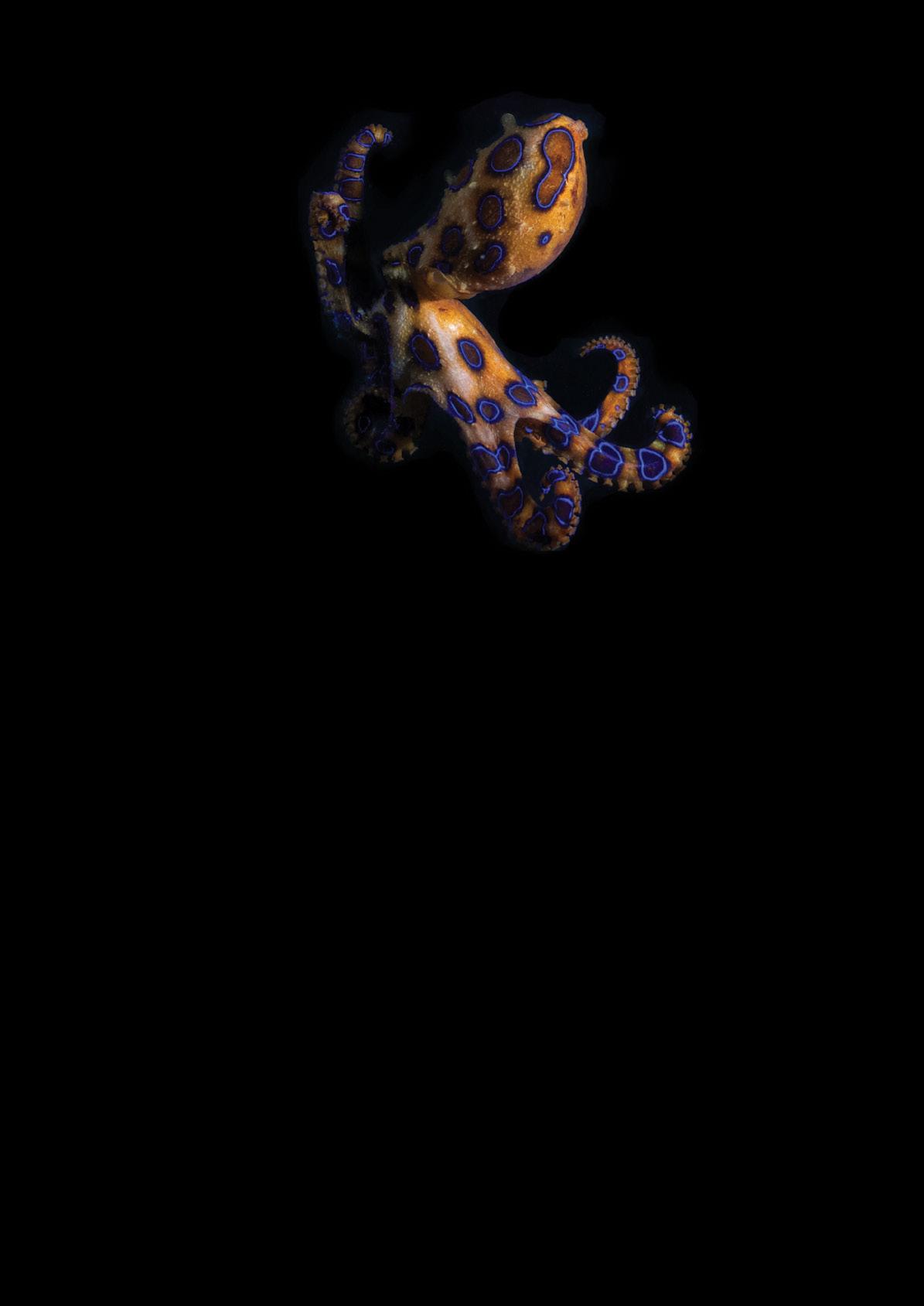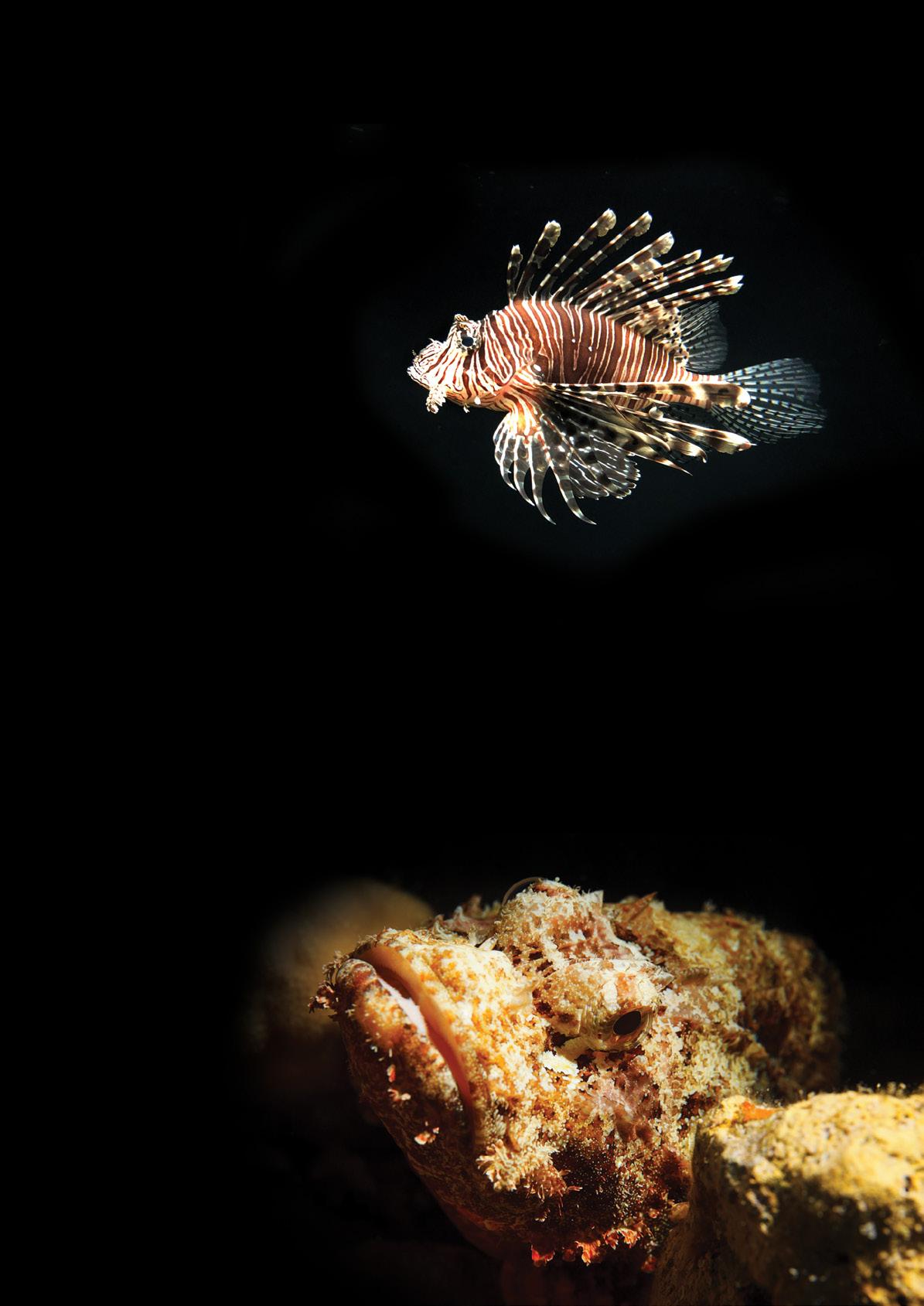
4 minute read
Australia’s dangerous marine animals
Australian waters contain a range of creatures that secrete toxins, inject venom, release poison, or just have sharp teeth. An unwanted encounter with any of these creatures can happen quickly, so it is essential that you and your crew are prepared.
By Shontelle Chamtaprieo
Advertisement
What kinds of dangerous fauna are we talking about?
Marine stingers. Australia’s marine and estuarine environment is home to numerous types of harmful jellyfish, collectively known as marine stingers. A sting from any of these can be painful, but the sting of the irukandji or the box jellyfish can be lethal.
Sea snakes. At least 32 species of sea snakes inhabit Australian waters. A small dose of venom is highly toxic, resulting in muscle pain and stiffness, drooping eyelids, drowsiness and vomiting. If it is a serious bite it can cause total paralysis and death. Immediate medical assistance is critical.
Venomous, poisonous or spiny fish. A number of hazardous fish inhabit Australian coastal waters. The most dangerous include stonefish, stingrays, eel-tailed catfish, bullrout, scorpionfish and rabbitfish.
Blue-ringed octopus. Blue-ringed octopi are very small and inhabit tide pools and shallow reefs, but fishers sometimes haul them up on deck with the catch. Despite its small size, the bite of the blue-ringed octopus carries enough venom to kill 26 adult humans within minutes.
Crocodiles. Crocodiles can be found in both saltwater and freshwater around the northern regions of Australia from the Kimberly region in Western Australia, across the north and down the coast of Queensland, south of Mackay.
Sharks. A number of shark species are prevalent around Australia, including the white pointer, bull shark and tiger shark. Clearly an encounter with a shark can have dire consequences.
Cone shell. There are 80 species of cone shell in shallow water, sand flats and reefs all around Australia from north Western Australia to southern Queensland. A small number are potentially lethal to humans, with their fast-acting venom, which can cause intense pain and swelling at the sting site, numbness, tingling, nausea and vomiting.
Sea urchins and Crown of Thorns starfish. Sea urchins are found in all Australian waters and although only some are venomous, their spines can be long and sharp, along with those of the Crown of Thorns starfish. These spines can pierce the skin and snap off, requiring surgical removal and causing a painful infection. The Crown of Thorns starfish can also release a neurotoxin through its spines, causing a sharp stinging pain that can last for hours, as well as nausea and vomiting.

Managing the risks
It is the owner’s responsibility to identify the risks associated with dangerous fauna and develop ways of controlling and responding to these risks in the vessel’s safety management system. The master is responsible for implementing the safety management system, while crew and others on board the vessel are responsible for following the instructions of the master.
Is there a risk?
Get informed about the dangerous marine life in your region. Record the kinds of dangerous marine fauna that you could have contact with during your operation. Assess the risk to you, your crew and others on board the vessel in all possible scenarios of your operation. What impact could the risk have if it became reality and how likely is it to happen?
Controlling the risk
The most effective control you can put in place, is to reduce the risk of a person coming into contact with dangerous marine fauna during your operations. Document these controls in your safety management system and make sure you train and induct crew and others on board the vessel in what to do in each scenario.

Blue-ringed octopus
iStock.com/Subaqueousshutterbug
Key preventative measures
Consider the danger to yourself before entering the water and whether tasks can be carried out another way.
Use personal protective equipment such as puncture resistant gloves (if there is a risk of contact with marine fauna with toxic or venomous stings, bites or spikes) and stinger suits (when entering waters where box jellyfish and other stingers are likely to exist). Consider the use of other equipment to handle dangerous marine creatures, such as hooks or grabbers used to remove sea snakes from fishing nets.
Make sure new crew members joining the vessel, and to a certain degree passengers, are aware of the risks posed by dangerous marine fauna, and the risk controls in place. Induct and train your crew and ensure policies and procedures are being followed.
What happens if risk becomes reality?
Implement emergency procedures to ensure a rapid response where a person is stung or bitten by poisonous or toxic marine fauna. Know what symptoms to monitor for, so that you can effectively respond as soon as possible.
Make sure the first aid kit is stocked for all the types of bites and stings you could encounter and ensure the crew are appropriately trained and inducted, so that that they are able to act in an emergency.
The New South Wales Poisons Information Centre provides some useful guidance on response strategies to bites and stings from dangerous marine fauna—refer to their website for further information.
Some dangerous marine fauna interactions will require emergency medical evacuation as soon as possible. Make sure you know who to call immediately for emergency assistance and have an effective means of communication to do so. This may include calling 000 if a mobile phone is accessible or radio for help on Channel 16 on VHF (distress calling channel).
Reminder
Reduce the risk of contact with dangerous marine fauna.
Document the risk assessment in your safety management system.
Ensure everyone on board the vessel is aware of the risks.
Plan how you and your crew will respond in an emergency.

Lionfish and stonefish
lionfish image: istock.com/mtreasure.; stonefish image: iStock.com/ultramarinfoto








